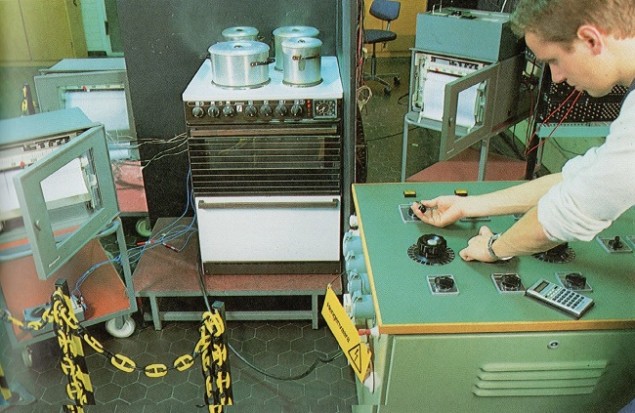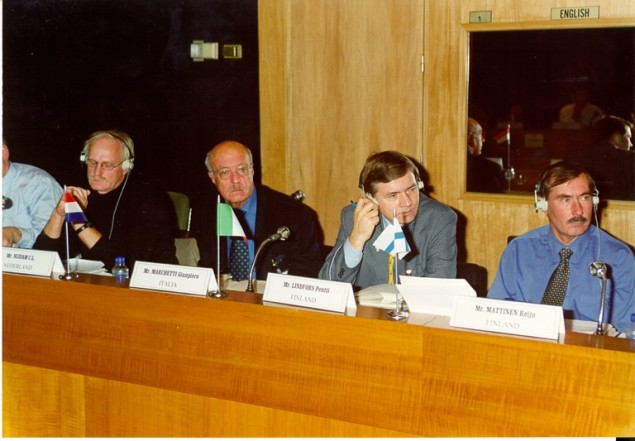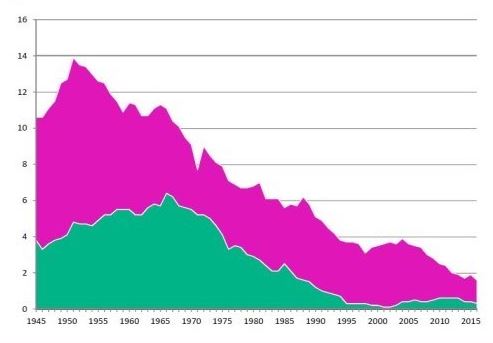The history of electrical safety, part V: from advance inspections to market surveillance
Tukes
Julkaisuajankohta
19.10.2017
14.09
Tyyppi:Tiedote
In our series on the history of electrical safety, we have reached the 1980s and 1990s. In the 1980s, electrical equipment was inspected before being launched on the market, and an FI approval marking was compulsory. All of this changed in the 1990s. Finland joined the European Union, the markets were deregulated, and the CE marking and the market surveillance of products were introduced. Surveillance and inspection activities were separated, the Electrical Inspectorate was abolished and its official functions were transferred to the Safety Technology Authority in Finland (the former TUKES), which operated under the Ministry of Trade and Industry.

Ensuring consumer safety. Household appliances are examined in the Electrical Inspectorate's laboratory.
The 1980s: The FI marking and compulsory advance inspection
The new Electricity Act entered into force on 1 January 1980, increasing the opportunities of public authorities to supervise and steer the overall supply of electricity. The provisions concerning electrical safety and those concerning the electricity supply organisation were clearly separated by the Act.
The design, construction and maintenance of electrical equipment and installations were defined as activities subject to a licence. Supervisory duties were assigned to the Electrical Inspectorate, which had been converted into a public corporation. The FI approval marking became compulsory.
The European Economic Community (EEC) discussed electrical safety, among other issues. Finland began investigating how the principles of the so-called Low Voltage Directive could be applied in Finland and how the directive might affect our country. In 1986, the Ministry of Trade and Industry set up a committee to examine the matter.
The 1990s: internationalisation and the effects of the EU
In 1994, Finland decided to join the European Union, and its membership became effective on 1 January 1995. This also marked the entry into force of an act requiring a CE marking to be affixed to certain products. This meant that the manufacturer or importer affirmed that the product fulfilled safety requirements. Meanwhile, the compulsory advance inspection of electrical equipment and the FI marking were abolished. A new type of market surveillance began in which the relevant authority supervises the safety of products that are already on the market.

International cooperation in the EU. A forum of supervisory authorities related to the Electromagnetic Compatibility (EMC) Directive in Madrid in 1999. Finland was represented by Technical Director Pentti Lindfors from the Finnish Communications Regulatory Authority and Chief Engineer Reijo Mattinen from the Safety Technology Authority.
Separation of surveillance and inspection activities
Surveillance and inspection activities related to electrical safety were separated in 1995–1996. The Electrical Inspectorate was abolished and its duties as a public authority were transferred to a new office, the Safety Technology Authority, which operated under the Ministry of Trade and Industry. The inspection of electrical apparatus and installations became a commercial activity. The Ministry was tasked with issuing acts and other binding regulations for the electrical sector.
Electrical safety
In 1996, a new Electrical Safety Act was introduced. It emphasised the responsibility of electricity professionals for their operations. The purpose of the act was to ensure the safe use of electrical appliances and installations, prevent any adverse effects of electromagnetic interference and safeguard the rights of victims who had suffered loss or damage caused by an electrical appliance or installation. The CE marking became compulsory in electrical products.
Based on the Electrical Safety Act, an Electrical Safety Decree was stipulated in order to regulate the qualifications for inspection and assessment duties.
Deregulation of the electricity market
In 1997, along with the Electricity Market Act and the resulting deregulation of the electricity market, the next step was to separate electricity generation from transmission. The main grid, which connects Finland’s largest power plants to major consumption hubs and transformer stations, was centralised into a single national grid company, Fingrid Oy.
How is electrical safety supervised?

Market surveillance of electrical equipment
Tukes’ inspectors supervise the safety of electrical equipment available in the market and their compliance with the requirements by, for example, visiting household appliance stores and other stores that may sell suspicious equipment. Any suspicious devices are taken to a competent testing body for testing. The importer may also be requested to provide proof of the product's compliance with requirements.
If the tests reveal any defects in the product, the responsible company can be charged for the testing costs. The importer or domestic manufacturer is contacted and required to repair the defects or stop selling the product.
Supervision of operators in the electricity sector
Tukes also supervises the activities of operators such as electrical contractors and the possessors of electrical installations. If safety regulations are violated, the activities of an installation company or the use of an electrical installation may be prohibited.
Qualification requirements for electrical works
Electrical works include the construction of electrical installations and the repair and maintenance of electrical equipment and installations. A person doing electrical work must have a certificate of qualification. A prerequisite for this is sufficient training and experience in the electrical sector, and proof of a passed safety examination. There are various qualification categories representing different levels of complexity of the work. Tukes is responsible for safety certification examinations, which are organised by AEL, adult education centres and vocational education institutions, among others. A certificate of qualification is issued by a nominated evaluation body.
Fatal electrical accidents, ten-year average 1945–2016

red=Laypersons, green=Professionals
Fatal electrical accidents
Accident statistics show that electrical safety has clearly improved over recent decades. Statistics on fatal electrical accidents have been compiled since the 1930s. From the 1930s to the 1950s, the number of victims of fatal accidents was five times higher than today. In the 1970s, the number was still three times higher. Since the 1990s, the number of fatal accidents has decreased from an average of four cases to approximately two per year. Accidents sustained by electricity professionals have decreased more than those of so-called laypersons.
Previous articles in this series:
http://verkkolehti.tukes.fi/sahkoturvallisuuden-historiaa-osa-iv/
http://verkkolehti.tukes.fi/sahkoturvallisuuden-historiaa-osa-3/
http://verkkolehti.tukes.fi/sahkoturvallisuuden-historiaa-osa-ii/
http://verkkolehti.tukes.fi/miten-sahkoturvallisuus-on-kehittynyt-suomessa/
Editor: Paula Kuusio


